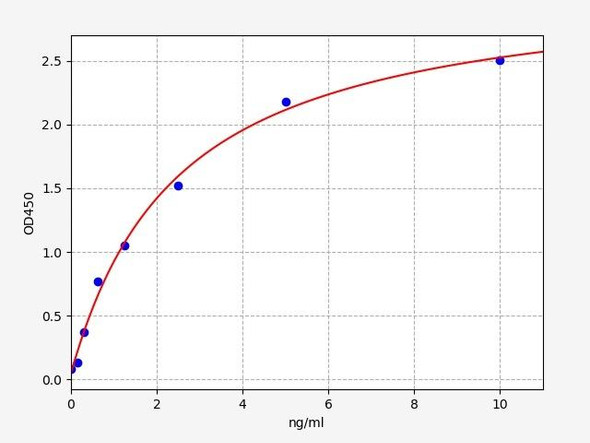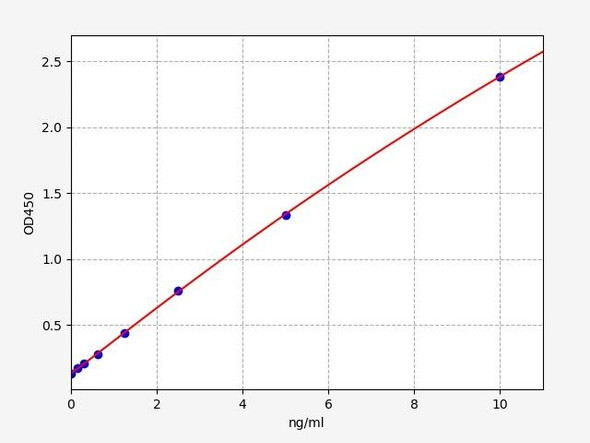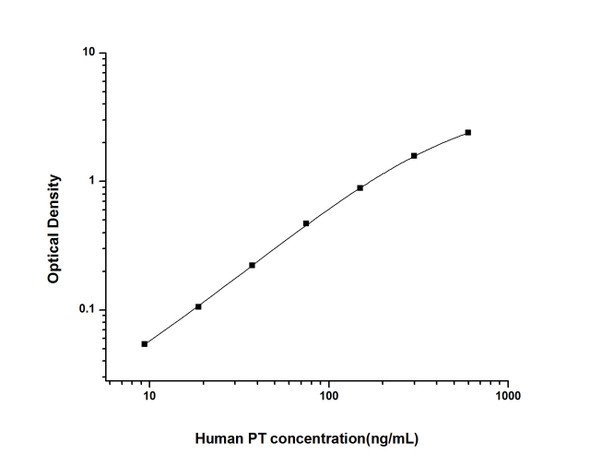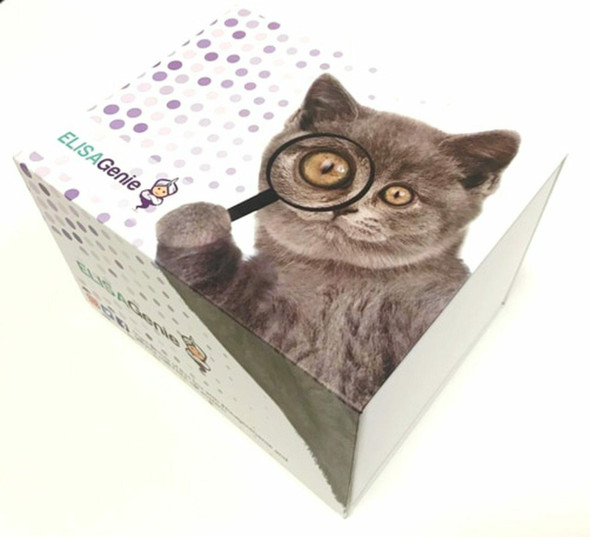Description
Mouse Prothrombin (F2) ELISA Kit
The Mouse Prothrombin (F2) ELISA Kit is specifically designed for the precise detection of prothrombin levels in mouse serum, plasma, and cell culture supernatants. With its exceptional sensitivity and specificity, this kit provides accurate and consistent results, making it an excellent choice for a variety of research applications.Prothrombin is a key protein in the blood clotting cascade, playing a crucial role in hemostasis and thrombosis.
Dysregulation of prothrombin levels can lead to bleeding disorders or increased risk of thrombosis, making it a valuable biomarker for studying these conditions and potential therapeutic interventions.The Mouse Prothrombin (F2) ELISA Kit offers researchers a reliable tool for studying prothrombin biology in mouse models, aiding in the development of new treatments and therapies for thrombotic and bleeding disorders.
| Product Name: | Mouse Prothrombin (F2) ELISA Kit |
| SKU: | MOEB0551 |
| Size: | 96T |
| Target: | Mouse Prothrombin (F2) |
| Synonyms: | Coagulation factor II, Cf2 |
| Assay Type: | Sandwich |
| Detection Method: | ELISA |
| Reactivity: | Mouse |
| Detection Range: | 1.56-100ng/mL |
| Sensitivity: | 0.8ng/mL |
| Intra CV: | 5.8% | ||||||||||||||||||||
| Inter CV: | 8.3% | ||||||||||||||||||||
| Linearity: |
| ||||||||||||||||||||
| Recovery: |
| ||||||||||||||||||||
| Function: | Thrombin, which cleaves bonds after Arg and Lys, converts fibrinogen to fibrin and activates factors V, VII, VIII, XIII, and, in complex with thrombomodulin, protein C. Functions in blood homeostasis, inflammation and wound healing. |
| Uniprot: | P19221 |
| Sample Type: | Serum, plasma, tissue homogenates, cell culture supernates and other biological fluids |
| Specificity: | Natural and recombinant mouse Prothrombin |
| Sub Unit: | Heterodimer (named alpha-thrombin) of a light and a heavy chain; disulfide-linked. Forms a heterodimer with SERPINA5. |
| Research Area: | Cancer |
| Storage: | Please see kit components below for exact storage details |
| Note: | For research use only |
| UniProt Protein Function: | prothrombin: Thrombin, which cleaves bonds after Arg and Lys, converts fibrinogen to fibrin and activates factors V, VII, VIII, XIII, and, in complex with thrombomodulin, protein C. Functions in blood homeostasis, inflammation and wound healing. Defects in F2 are the cause of factor II deficiency (FA2D). It is a very rare blood coagulation disorder characterized by mucocutaneous bleeding symptoms. The severity of the bleeding manifestations correlates with blood factor II levels. Genetic variations in F2 may be a cause of susceptibility to ischemic stroke (ISCHSTR); also known as cerebrovascular accident or cerebral infarction. A stroke is an acute neurologic event leading to death of neural tissue of the brain and resulting in loss of motor, sensory and/or cognitive function. Ischemic strokes, resulting from vascular occlusion, is considered to be a highly complex disease consisting of a group of heterogeneous disorders with multiple genetic and environmental risk factors. Defects in F2 are the cause of thrombophilia due to thrombin defect (THPH1). It is a multifactorial disorder of hemostasis characterized by abnormal platelet aggregation in response to various agents and recurrent thrombi formation. A common genetic variation in the 3-prime untranslated region of the prothrombin gene is associated with elevated plasma prothrombin levels and an increased risk of venous thrombosis. Defects in F2 are associated with susceptibility to pregnancy loss, recurrent, type 2 (RPRGL2). A common complication of pregnancy, resulting in spontaneous abortion before the fetus has reached viability. The term includes all miscarriages from the time of conception until 24 weeks of gestation. Recurrent pregnancy loss is defined as 3 or more consecutive spontaneous abortions. Belongs to the peptidase S1 family. |
| UniProt Protein Details: | Protein type:Secreted; Apoptosis; EC 3.4.21.5; Secreted, signal peptide; Protease Cellular Component: extracellular matrix; extracellular space; cell; extracellular region; cytosol Molecular Function:peptidase activity; protein binding; hydrolase activity; serine-type peptidase activity; serine-type endopeptidase activity; calcium ion binding; catalytic activity; receptor binding Biological Process: negative regulation of proteolysis; platelet activation; positive regulation of blood coagulation; cytosolic calcium ion homeostasis; positive regulation of collagen biosynthetic process; proteolysis; positive regulation of cell growth; positive regulation of phosphoinositide 3-kinase cascade; regulation of cell shape; fibrinolysis; cell surface receptor linked signal transduction; hemostasis; regulation of gene expression; negative regulation of astrocyte differentiation; positive regulation of cell proliferation; acute-phase response; response to wounding; positive regulation of protein amino acid phosphorylation; positive regulation of release of sequestered calcium ion into cytosol; blood coagulation |
| NCBI Summary: | This gene encodes a vitamin K-dependent glycoprotein coagulation factor that plays an important role in the process of blood coagulation and hemostasis. The encoded protein is an inactive zymogen that undergoes enzymatic cleavage by the coagulation factor Xa to form an active serine protease that converts soluble fibrinogen to insoluble fibrin clot. Most of the mice lacking the encoded protein die at an embryonic stage due to defects in yolk sac vasculature, while the rare nenonates succumb to hemorrhage on the first postnatal day. [provided by RefSeq, Apr 2015] |
| UniProt Code: | P19221 |
| NCBI GenInfo Identifier: | 6753798 |
| NCBI Gene ID: | 14061 |
| NCBI Accession: | NP_034298.1 |
| UniProt Related Accession: | P19221 |
| Molecular Weight: | 36,700 |
| NCBI Full Name: | prothrombin |
| NCBI Synonym Full Names: | coagulation factor II |
| NCBI Official Symbol: | F2 |
| NCBI Official Synonym Symbols: | Cf2; FII; Cf-2; thrombin |
| NCBI Protein Information: | prothrombin |
| UniProt Protein Name: | Prothrombin |
| UniProt Synonym Protein Names: | Coagulation factor II |
| Protein Family: | Thrombin |
| UniProt Gene Name: | F2 |
| UniProt Entry Name: | THRB_MOUSE |
| Component | Quantity (96 Assays) | Storage |
| ELISA Microplate (Dismountable) | 8×12 strips | -20°C |
| Lyophilized Standard | 2 | -20°C |
| Sample Diluent | 20ml | -20°C |
| Assay Diluent A | 10mL | -20°C |
| Assay Diluent B | 10mL | -20°C |
| Detection Reagent A | 120µL | -20°C |
| Detection Reagent B | 120µL | -20°C |
| Wash Buffer | 30mL | 4°C |
| Substrate | 10mL | 4°C |
| Stop Solution | 10mL | 4°C |
| Plate Sealer | 5 | - |
Other materials and equipment required:
- Microplate reader with 450 nm wavelength filter
- Multichannel Pipette, Pipette, microcentrifuge tubes and disposable pipette tips
- Incubator
- Deionized or distilled water
- Absorbent paper
- Buffer resevoir
*Note: The below protocol is a sample protocol. Protocols are specific to each batch/lot. For the correct instructions please follow the protocol included in your kit.
Allow all reagents to reach room temperature (Please do not dissolve the reagents at 37°C directly). All the reagents should be mixed thoroughly by gently swirling before pipetting. Avoid foaming. Keep appropriate numbers of strips for 1 experiment and remove extra strips from microtiter plate. Removed strips should be resealed and stored at -20°C until the kits expiry date. Prepare all reagents, working standards and samples as directed in the previous sections. Please predict the concentration before assaying. If values for these are not within the range of the standard curve, users must determine the optimal sample dilutions for their experiments. We recommend running all samples in duplicate.
| Step | |
| 1. | Add Sample: Add 100µL of Standard, Blank, or Sample per well. The blank well is added with Sample diluent. Solutions are added to the bottom of micro ELISA plate well, avoid inside wall touching and foaming as possible. Mix it gently. Cover the plate with sealer we provided. Incubate for 120 minutes at 37°C. |
| 2. | Remove the liquid from each well, don't wash. Add 100µL of Detection Reagent A working solution to each well. Cover with the Plate sealer. Gently tap the plate to ensure thorough mixing. Incubate for 1 hour at 37°C. Note: if Detection Reagent A appears cloudy warm to room temperature until solution is uniform. |
| 3. | Aspirate each well and wash, repeating the process three times. Wash by filling each well with Wash Buffer (approximately 400µL) (a squirt bottle, multi-channel pipette,manifold dispenser or automated washer are needed). Complete removal of liquid at each step is essential. After the last wash, completely remove remaining Wash Buffer by aspirating or decanting. Invert the plate and pat it against thick clean absorbent paper. |
| 4. | Add 100µL of Detection Reagent B working solution to each well. Cover with the Plate sealer. Incubate for 60 minutes at 37°C. |
| 5. | Repeat the wash process for five times as conducted in step 3. |
| 6. | Add 90µL of Substrate Solution to each well. Cover with a new Plate sealer and incubate for 10-20 minutes at 37°C. Protect the plate from light. The reaction time can be shortened or extended according to the actual color change, but this should not exceed more than 30 minutes. When apparent gradient appears in standard wells, user should terminatethe reaction. |
| 7. | Add 50µL of Stop Solution to each well. If color change does not appear uniform, gently tap the plate to ensure thorough mixing. |
| 8. | Determine the optical density (OD value) of each well at once, using a micro-plate reader set to 450 nm. User should open the micro-plate reader in advance, preheat the instrument, and set the testing parameters. |
| 9. | After experiment, store all reagents according to the specified storage temperature respectively until their expiry. |
When carrying out an ELISA assay it is important to prepare your samples in order to achieve the best possible results. Below we have a list of procedures for the preparation of samples for different sample types.
| Sample Type | Protocol |
| Serum | If using serum separator tubes, allow samples to clot for 30 minutes at room temperature. Centrifuge for 10 minutes at 1,000x g. Collect the serum fraction and assay promptly or aliquot and store the samples at -80°C. Avoid multiple freeze-thaw cycles. If serum separator tubes are not being used, allow samples to clot overnight at 2-8°C. Centrifuge for 10 minutes at 1,000x g. Remove serum and assay promptly or aliquot and store the samples at -80°C. Avoid multiple freeze-thaw cycles. |
| Plasma | Collect plasma using EDTA or heparin as an anticoagulant. Centrifuge samples at 4°C for 15 mins at 1000 × g within 30 mins of collection. Collect the plasma fraction and assay promptly or aliquot and store the samples at -80°C. Avoid multiple freeze-thaw cycles. Note: Over haemolysed samples are not suitable for use with this kit. |
| Urine & Cerebrospinal Fluid | Collect the urine (mid-stream) in a sterile container, centrifuge for 20 mins at 2000-3000 rpm. Remove supernatant and assay immediately. If any precipitation is detected, repeat the centrifugation step. A similar protocol can be used for cerebrospinal fluid. |
| Cell culture supernatant | Collect the cell culture media by pipette, followed by centrifugation at 4°C for 20 mins at 1500 rpm. Collect the clear supernatant and assay immediately. |
| Cell lysates | Solubilize cells in lysis buffer and allow to sit on ice for 30 minutes. Centrifuge tubes at 14,000 x g for 5 minutes to remove insoluble material. Aliquot the supernatant into a new tube and discard the remaining whole cell extract. Quantify total protein concentration using a total protein assay. Assay immediately or aliquot and store at ≤ -20 °C. |
| Tissue homogenates | The preparation of tissue homogenates will vary depending upon tissue type. Rinse tissue with 1X PBS to remove excess blood & homogenize in 20ml of 1X PBS (including protease inhibitors) and store overnight at ≤ -20°C. Two freeze-thaw cycles are required to break the cell membranes. To further disrupt the cell membranes you can sonicate the samples. Centrifuge homogenates for 5 mins at 5000xg. Remove the supernatant and assay immediately or aliquot and store at -20°C or -80°C. |
| Tissue lysates | Rinse tissue with PBS, cut into 1-2 mm pieces, and homogenize with a tissue homogenizer in PBS. Add an equal volume of RIPA buffer containing protease inhibitors and lyse tissues at room temperature for 30 minutes with gentle agitation. Centrifuge to remove debris. Quantify total protein concentration using a total protein assay. Assay immediately or aliquot and store at ≤ -20 °C. |
| Breast Milk | Collect milk samples and centrifuge at 10,000 x g for 60 min at 4°C. Aliquot the supernatant and assay. For long term use, store samples at -80°C. Minimize freeze/thaw cycles. |










